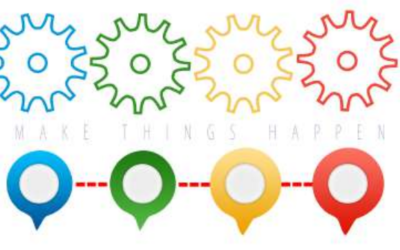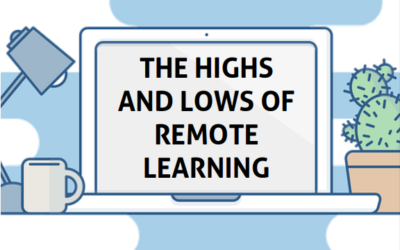Fractions and decimals can drive a lot of us crazy. After learning “big” or “long numbers” are larger, suddenly fractions and decimals come along to flip these assumptions upside-down. For dyslexic students, care must be taken at the first step of understanding the equivalences among the different representations of fractions and decimals before moving onto calculations. WHY STUDENTS MAY STRUGGLE WITH FRACTIONS AND DECIMALS Creative Maths has a nice summary of why decimals are so difficult. An excerpt: “Without zero, 2001 and 201 and 21 would all look the same! From early on we recognize that longer numbers represent larger quantities. We know that a salary with lots of zeroes is better than one with only a few. $1000000 is more than $200 even […]
Reading and Learning are About Thinking [Premium]
“Then a strange thing happened. The more I started thinking about what we were studying, the easier it was to remember the facts. Facts began to stick in my head — and I didn’t even have to try to make it happen…” — Don Johnston, CEO After using Don Johnston’s assistive technology with our kids when they were growing up, it was such a pleasure for us to meet Don Johnston himself for the first time a few weeks ago. We hadn’t known that he is dyslexic and before we met, he shared his autobiography (for kids), Building Wings. The book is available in e-book form HERE and otherwise through Amazon. Like many dyslexic adults, Don vividly remembers events from his childhood and school […]
Mind Mapping Math
Fractions can be confusing. Some students are confused by the new terminology that comes with fractions (numerator, denominator), while others are confused because they seem to have different principles from those learned from whole numbers. Numbers that "get bigger"...
Recovering from Pandemic Loss
Numbers are starting to trickle in from February testing and the good news is that things are beginning to recover, but younger grades are behind more than older children. The numbers below are all students, without dyslexic students studied separately, but if...
From High School Drop-Out to VP of Engineering [Premium]
There are some people who are so insightful into their cognitive processes that talking to them is pure gold. Gary MacGregor is one of those people – he’s a VP of an electronic device company and recent PhD recipient from the University of Texas at Austin. He has a remarkable story and has been very generous in sharing what he has learned. Gary: “I’m a high school dropout. My parents were high school dropouts. I’m the first male in the family to go to college.” When Gary dropped out of school, he took a job working an oil refinery – a lucrative career for a person without a high school diploma. While he was working 12 hour shifts 84 hours a week, he would exercise […]
Math Strategies Instead of Drill [Premium]
In the many years Brock and I spent testing and listening to dyslexic students at every level of education, we often heard first hand accounts of how they learned how to tackle difficult subjects and bypass school-related challenges. As research studies bear out (for instance, see Kirby’s study of dyslexic university students), many dyslexic students in higher education have arrived at where they are because they are deep learners, savvy about how they learn best, and strategic in how they approach school. Brain-Based Reasons Why Math Strategies Are Better for Dyslexics Than Drill But there is also neurobiological evidence that supports why strategies may be a superior route for dyslexic learning compared to drill or simple repetition. By now, anyone who knows about brain […]
How Not to Learn to Read aka Death by Worksheets [Premium]
Daniel Shanahan recently recounted his discussion with a principal about his school curriculum. His students were under-performing and he assured Daniel that students were receiving plenty of instruction in phonics and fluency. When he looked at the teacher’s curricular plan, it looked as if plenty of reading instruction was given every day, but his impression changed once he began visiting classes. Daniel: “Much of the instructional time wasn’t used for instruction at all. The teachers spent a big chunk of time on “sustained silent reading” and they read to the children quite a bit, too. All the classrooms had multiple reading groups. That meant that the boys and girls did a lot of worksheets to keep them quiet while the others were reading with […]
Visual Notes for Understanding: Science [Premium]
Note-taking may be a lifelong difficulty for most dyslexics. In one survey of 17 universities in the United Kingdom (HERE), 78% reported difficulties with taking notes compared to 47% reporting reading difficulties. The reason for note-taking difficulties are several – note-taking requires a great deal of working memory and divided attention, but also there’s the transcription of heard words to written words which can be difficult for a number of reasons, not the least, weakness in visual word form memory and for some students, auditory processing. Most dyslexic students should have classroom notes or other note-taking accommodations (like a designated note taker, Livescribe pen, or other option to record) as a standard condition. It is possible to learn how to visual note-take in real-time, but […]
The Highs and Lows of Remote Learning
"I don’t know how I’ll get through this. I know I must, but I am beyond exhausted." - a parent, APM Reports "What did we do to deserve this torture?" - a student about I-Ready By now, many school children and university students around the world have had some...
MATH: Learning Through Examples, Not Repetition and Drill [Premium]
“… children with dyslexia, because of disruption to left hemisphere language area, use a less optimal route for retrieval-base arithmetic, engaging right hemisphere parietal regions typically used by good readers for procedural-based arithmetic.” — Evans et al, 2014 TEACH MATH TO DYSLEXIC STUDENTS THROUGH STRENGTHS It was a research group at Georgetown University that first made the observations that a group of school age dyslexic students used a different brain strategy when doing single digit arithmetic. As it turns out, an area of the brain (left angular gyrus) implicated in some of reading difficulties associated with dyslexia is also the area of the brain that processes math learning through drill in non-dyslexic kids. So math drill may be the exactly wrong way to teach […]
Getting a Sense for Numbers [Premium]
For many, math is a somewhat mysterious subject. From an early age, some students may stand out from others in their mathematical ability whereas others don’t and some may seem to have bewildering difficulty with even basic aspects of numbers and math quantity. The last decade has seen significant advances in our understanding of individual learning differences when it comes to math. If you are a teacher, tutor, or parent working with a student with math challenges, understanding the basic extent of the difficulty will help guide you about knowing how to help. POOR NUMBER SENSE Poor number sense is a problem noticed at the very start when children begin working with numbers and quantities. A student may memorize how to count (“1,2,3,4…”), but […]
Rapid Automatized Naming (RAN) and Its Impact on Dyslexia [Premium]
“Substantial evidence shows that dyslexic readers have problems with rapid naming of visual items. Early research assumed that this was a consequence of phonological processing deficits, but recent findings suggest that non-phonological processes may lie at the root of the association between slow naming speed and poor reading. The hypothesis that rapid naming reflects an independent core deficit in dyslexia is supported by the main findings: (1) some dyslexics are characterized by rapid naming difficulties but intact phonological skills; (2) evidence for an independent association between rapid naming and reading competence in the dyslexic readers, when the effect of phonological skills was controlled; (3) rapid naming and phonological processing measures are not reliably correlated. “ – Araujo et al. 2011 Rapid automatized naming or […]

![How to Not Go Crazy from Fractions and Decimals [Premium]](https://www.dyslexicadvantage.org/wp-content/uploads/2022/05/math-dyslexia-decimals-fractions-400x250.png)
![Reading and Learning are About Thinking [Premium]](https://www.dyslexicadvantage.org/wp-content/uploads/2022/05/READING-AND-LEARNING-ARE-ABOUT-THINKING-400x250.jpg)


![From High School Drop-Out to VP of Engineering [Premium]](https://www.dyslexicadvantage.org/wp-content/uploads/2022/04/From-High-School-Dropout-April-2022-Premium-3-400x250.png)
![Math Strategies Instead of Drill [Premium]](https://www.dyslexicadvantage.org/wp-content/uploads/2022/03/Math-Strategies-Instead-of-Drill-DA-Premium-March-2022-2-e1648381776105-400x250.png)
![How Not to Learn to Read aka Death by Worksheets [Premium]](https://www.dyslexicadvantage.org/wp-content/uploads/2022/03/kawin-harasai-2Ev2aUB8NJI-unsplash-400x250.jpg)
![Visual Notes for Understanding: Science [Premium]](https://www.dyslexicadvantage.org/wp-content/uploads/2022/03/Visual-Notes-DA-Premium-March-2022-400x250.png)

![MATH: Learning Through Examples, Not Repetition and Drill [Premium]](https://www.dyslexicadvantage.org/wp-content/uploads/2022/01/Learning-through-Examples-4-400x250.png)
![Getting a Sense for Numbers [Premium]](https://www.dyslexicadvantage.org/wp-content/uploads/2021/12/Sense-for-numbers-e1642618957111-400x250.jpg)
![Rapid Automatized Naming (RAN) and Its Impact on Dyslexia [Premium]](https://www.dyslexicadvantage.org/wp-content/uploads/2021/12/Rapid-Automatized-Naming-357x250.png)













